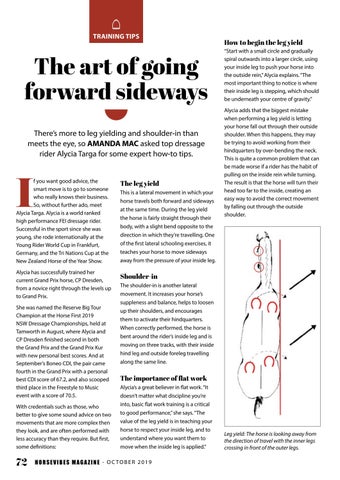TRAINING TIPS
The art of going forward sideways There’s more to leg yielding and shoulder-in than meets the eye, so AMANDA MAC asked top dressage rider Alycia Targa for some expert how-to tips.
I
f you want good advice, the smart move is to go to someone who really knows their business. So, without further ado, meet Alycia Targa. Alycia is a world ranked high performance FEI dressage rider. Successful in the sport since she was young, she rode internationally at the Young Rider World Cup in Frankfurt, Germany, and the Tri Nations Cup at the New Zealand Horse of the Year Show. Alycia has successfully trained her current Grand Prix horse, CP Dresden, from a novice right through the levels up to Grand Prix. She was named the Reserve Big Tour Champion at the Horse First 2019 NSW Dressage Championships, held at Tamworth in August, where Alycia and CP Dresden finished second in both the Grand Prix and the Grand Prix Kur with new personal best scores. And at September’s Boneo CDI, the pair came fourth in the Grand Prix with a personal best CDI score of 67.2, and also scooped third place in the Freestyle to Music event with a score of 70.5. With credentials such as those, who better to give some sound advice on two movements that are more complex then they look, and are often performed with less accuracy than they require. But first, some definitions:
72
The leg yield This is a lateral movement in which your horse travels both forward and sideways at the same time. During the leg yield the horse is fairly straight through their body, with a slight bend opposite to the direction in which they’re travelling. One of the first lateral schooling exercises, it teaches your horse to move sideways away from the pressure of your inside leg.
How to begin the leg yield “Start with a small circle and gradually spiral outwards into a larger circle, using your inside leg to push your horse into the outside rein,” Alycia explains. “The most important thing to notice is where their inside leg is stepping, which should be underneath your centre of gravity.” Alycia adds that the biggest mistake when performing a leg yield is letting your horse fall out through their outside shoulder. When this happens, they may be trying to avoid working from their hindquarters by over-bending the neck. This is quite a common problem that can be made worse if a rider has the habit of pulling on the inside rein while turning. The result is that the horse will turn their head too far to the inside, creating an easy way to avoid the correct movement by falling out through the outside shoulder.
Shoulder-in The shoulder-in is another lateral movement. It increases your horse’s suppleness and balance, helps to loosen up their shoulders, and encourages them to activate their hindquarters. When correctly performed, the horse is bent around the rider’s inside leg and is moving on three tracks, with their inside hind leg and outside foreleg travelling along the same line.
The importance of flat work Alycia’s a great believer in flat work. “It doesn’t matter what discipline you’re into, basic flat work training is a critical to good performance,” she says. “The value of the leg yield is in teaching your horse to respect your inside leg, and to understand where you want them to move when the inside leg is applied.”
HORSEVIBES MAGAZINE - OC TOBER 2019
Leg yield: The horse is looking away from the direction of travel with the inner legs crossing in front of the outer legs.


















